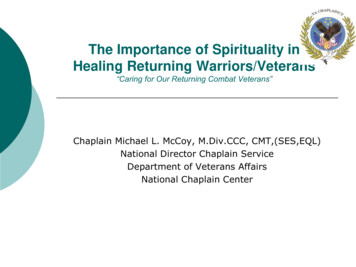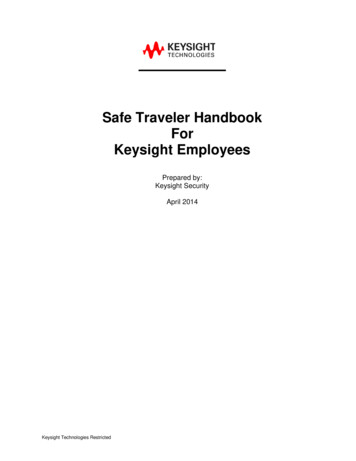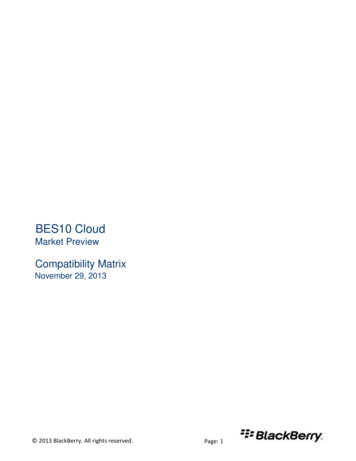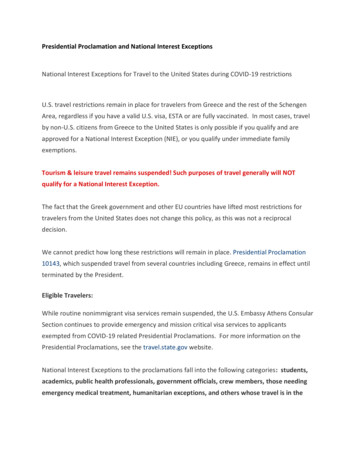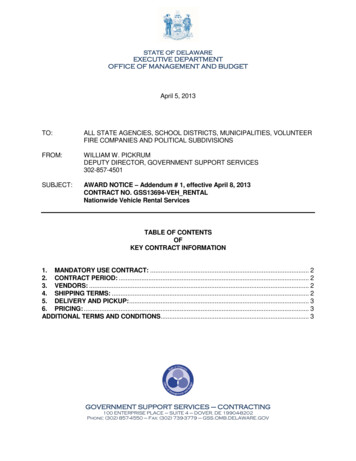
Transcription
Morbidity and Mortality Weekly ReportWeekly / Vol. 71 / No. 14April 8, 2022Monkeypox in a Traveler Returning from Nigeria — Dallas, Texas, July 2021Agam K. Rao, MD1; Joann Schulte, DO2; Tai-Ho Chen, MD3; Christine M. Hughes, MPH1; Whitni Davidson, MPH1; Justin M. Neff, MD4;Mary Markarian2; Kristin C. Delea, MPH3; Suzanne Wada, MD2; Allison Liddell, MD4; Shane Alexander, DO4; Brittany Sunshine, MPH5;Philip Huang, MD2; Heidi Threadgill Honza, MPH6; Araceli Rey, MPH3; Benjamin Monroe, MPH1; Jeffrey Doty, MS1; Bryan Christensen, PhD7;Lisa Delaney, MS8; Joel Massey, MD6; Michelle Waltenburg, DVM1; Caroline A. Schrodt, MD7; David Kuhar, MD7; Panayampalli S. Satheshkumar, PhD1;Ashley Kondas, PhD1; Yu Li, PhD1; Kimberly Wilkins1; Kylie M. Sage, MS9; Yon Yu, PharmD5; Patricia Yu, MPH5; Amanda Feldpausch, DVM10;Jennifer McQuiston, DVM1; Inger K. Damon, MD, PhD1; Andrea M. McCollum, PhD1; July 2021 Monkeypox Response TeamMonkeypox is a rare, sometimes life-threatening zoonoticinfection that occurs in west and central Africa. It is causedby Monkeypox virus, an orthopoxvirus similar to Variola virus(the causative agent of smallpox) and Vaccinia virus (the livevirus component of orthopoxvirus vaccines) and can spreadto humans. After 39 years without detection of humandisease in Nigeria, an outbreak involving 118 confirmedcases was identified during 2017–2018 (1); sporadic casescontinue to occur. During September 2018–May 2021, sixunrelated persons traveling from Nigeria received diagnosesof monkeypox in non-African countries: four in the UnitedKingdom and one each in Israel and Singapore. In July 2021,a man who traveled from Lagos, Nigeria, to Dallas, Texas,became the seventh traveler to a non-African country withdiagnosed monkeypox. Among 194 monitored contacts, 144(74%) were flight contacts. The patient received tecovirimat,an antiviral for treatment of orthopoxvirus infections, and hishome required large-scale decontamination. Whole genomesequencing showed that the virus was consistent with a strainof Monkeypox virus known to circulate in Nigeria, but thespecific source of the patient’s infection was not identified.No epidemiologically linked cases were reported in Nigeria;no contact received postexposure prophylaxis (PEP) with theorthopoxvirus vaccine ACAM2000.FindingsOn July 13, 2021, an emergency department (ED) physician in Dallas evaluated an early middle-aged man* with a* Past medical history and identifying information withheld to protect patientconfidentiality.2-week history of fever, cough, and fatigue, followed by onsetof a diffuse rash. Less than 1 week earlier, the patient hadbeen in Nigeria for a large social gathering. Because of theextensive pustular rash on his face, hospital staff membersimmediately placed the patient in an airborne isolation room,where he was managed with airborne and contact precautionsplus eye protection. After reviewing CDC’s Travelers’ Healthdestination webpage for Nigeria,† the ED physician suspectedmonkeypox, and public health authorities were immediatelynotified. The following day, the Dallas County Health and† /none/nigeria?s cid%20 %20ncezid-dgmq-travel-single-001INSIDE517 Cardiac Complications After SARS-CoV-2 Infectionand mRNA COVID-19 Vaccination — PCORnet,United States, January 2021–January 2022524 Notes from the Field: SARS-CoV-2 Omicron VariantInfection in 10 Persons Within 90 Days of PreviousSARS-CoV-2 Delta Variant Infection — Four States,October 2021–January 2022527 Notes from the Field: EnteropathogenicEscherichia coli Outbreak at a Child Care Center —Oregon, August 2021529 QuickStatsContinuing Education examination available athttps://www.cdc.gov/mmwr/mmwr continuingEducation.htmlU.S. Department of Health and Human ServicesCenters for Disease Control and Prevention
Morbidity and Mortality Weekly ReportHuman Services Laboratory Response Network laboratoryconfirmed, by real-time polymerase chain reaction (PCR), thepresence of nonvariola orthopoxvirus DNA from lesion swabs.Subsequent testing by species-specific real-time PCR at CDCconfirmed West African clade Monkeypox virus.Interviews revealed that the patient had arrived in Nigeriaon June 25 and stayed in three urban centers during his trip(Figure). By June 30, he began experiencing diarrhea, vomiting,cough, subjective fever, and fatigue, all characteristic signs andsymptoms of the monkeypox prodrome, which also mark theonset of transmissibility of the virus to others (e.g., throughinfected body fluids or respiratory droplets). On July 8, 1 daybefore boarding the first of two return flights, the patientdeveloped a purulent rash confined to a covered part of hisbody. After a brief layover in the Atlanta airport, he took adomestic flight to Dallas, and then a ride-share vehicle to hisresidence, where he lives alone. The next day, the rash hadworsened and was visible on his face, prompting a friend todrive him to the hospital on July 13. Like many persons hisage, the patient had never received the smallpox vaccine, whichwould have provided cross-protection against monkeypox (2)but has not been routinely administered following the eradication of smallpox in 1980 (3).Public Health ResponseCDC, state and local public health authorities, and thetreating clinicians launched an intensive investigation duringJuly 13–September 4. Investigators reviewed what is knownabout orthopoxviruses and, through iterative discussions, categorized exposures as high, intermediate, low/uncertain, or norisk (Table). Exposures were ascertained through informationcollected from airport video surveillance, the patient’s reportof his activities and interactions with others, and flight seatingassignments. This activity was reviewed by CDC and was conducted consistent with applicable federal law and CDC policy.§Notifications were immediately issued to the public viapress releases; clinicians through the Health Alert Network;country national focal points, including those in Nigeria, underguidelines of the International Health Regulations (2005); public health officials via an Epi-X¶; and a call with state healthdepartments. Airline and federal partners provided information for flight contacts. Simultaneously, investigators discusseddisinfection of potentially contaminated surfaces. Transmissionto passengers on subsequent flights was considered unlikelybecause the disinfectants used between flights included a labelclaim for inactivation of Vaccinia virus, suggesting effectiveinactivation of Monkeypox virus. Airport bathrooms used bythe patient were confirmed to have been regularly cleaned withsimilarly effective products. The owners of the two cars usedby the patient were instructed to disinfect high-touch surfacesin the car with such products.§ 45C.F.R. part 46, 21 C.F.R. part 56; 42 U.S.C. Sect. 241(d); 5 U.S.C. Sect.552a; 44 U.S.C. Sect. 3501 et seq.¶ https://emergency.cdc.gov/epix/index.aspThe MMWR series of publications is published by the Center for Surveillance, Epidemiology, and Laboratory Services, Centers for Disease Control and Prevention (CDC),U.S. Department of Health and Human Services, Atlanta, GA 30329-4027.Suggested citation: [Author names; first three, then et al., if more than six.] [Report title]. MMWR Morb Mortal Wkly Rep 2022;71:[inclusive page numbers].Centers for Disease Control and PreventionRochelle P. Walensky, MD, MPH, DirectorDebra Houry, MD, MPH, Acting Principal Deputy DirectorDaniel B. Jernigan, MD, MPH, Deputy Director for Public Health Science and SurveillanceRebecca Bunnell, PhD, MEd, Director, Office of ScienceJennifer Layden, MD, PhD, Deputy Director, Office of ScienceLeslie Dauphin, PhD, Director, Center for Surveillance, Epidemiology, and Laboratory ServicesMMWR Editorial and Production Staff (Weekly)Charlotte K. Kent, PhD, MPH, Editor in ChiefBrian A. King, PhD, MPH, Executive EditorJacqueline Gindler, MD, EditorPaul Z. Siegel, MD, MPH, Associate EditorMary Dott, MD, MPH, Online EditorTerisa F. Rutledge, Managing EditorTeresa M. Hood, MS, Lead Technical Writer-EditorLeigh Berdon, Glenn Damon, Soumya Dunworth, PhD,Tiana Garrett-Cherry, PhD, MPH, Srila Sen, MA,Stacy Simon, MA, Jesse Sokolow, Morgan Thompson,Technical Writer-EditorsMartha F. Boyd, Lead Visual Information SpecialistAlexander J. Gottardy, Maureen A. Leahy,Julia C. Martinroe, Stephen R. Spriggs, Tong Yang,Visual Information SpecialistsQuang M. Doan, MBA, Phyllis H. King,Terraye M. Starr, Moua Yang,Information Technology SpecialistsIan Branam, MA,Acting Lead Health Communication SpecialistShelton Bartley, MPH, Leslie Hamlin,Lowery Johnson, Amanda Ray,Health Communication SpecialistsWill Yang, MA,Visual Information SpecialistMMWR Editorial BoardMatthew L. Boulton, MD, MPHCarolyn Brooks, ScD, MAJay C. Butler, MDVirginia A. Caine, MDJonathan E. Fielding, MD, MPH, MBADavid W. Fleming, MD510Timothy F. Jones, MD, ChairmanWilliam E. Halperin, MD, DrPH, MPHJewel Mullen, MD, MPH, MPAJeff Niederdeppe, PhDCeleste Philip, MD, MPHPatricia Quinlisk, MD, MPHPatrick L. Remington, MD, MPHMMWR / April 8, 2022 / Vol. 71 / No. 14Carlos Roig, MS, MAWilliam Schaffner, MDNathaniel Smith, MD, MPHMorgan Bobb Swanson, BSAbbigail Tumpey, MPHUS Department of Health and Human Services/Centers for Disease Control and Prevention
Morbidity and Mortality Weekly ReportFIGURE. Time line of patient activities and potential exposures to Monkeypox virus from patient’s arrival in Lagos, Nigeria to completion ofmonitoring for the last exposed known contact — Dallas, Texas, June–September 2021Nigeria (June 25–July 8, 2021)United States (July 9, 2021–September 4, 2021)July 13Arrival at Dallas EDand beginning ofhospitalizationJune 30Prodromeonset2530July 7Rashonset5July 9FlightfromAtlanta,Georgiato Dallas10JunJune 25Arrivalin LagosSeptember 4Last contactcompletedmonitoringAugust 14Discharge fromhospitalJuly 2July 8Presence Flight fromat largeLagos 429Aug3SepInfectious periodExposures on flights (147 contacts)Exposures from Dallas arrival until hospital evaluation (4 contacts)Exposures during hospitalization, including to Utah laboratory personnel (46 contacts)Abbreviation: ED emergency department.A total of 223 contacts were identified. A 24/7 CDC monkeypox call center was established to coordinate daily monitoring from 21 U.S. jurisdictions where contacts resided andto provide clinical consultations to physicians who suspectedadditional cases. Recommendations about monitoring andPEP were strongest for persons with high (no persons) orintermediate (34 persons) risk. Some exposures were categorized or recategorized to a higher or lower risk level becauseof circumstances unique to this event. For example, typically,persons who used the same lavatory as the patient would becategorized as no risk; however, because the patient used themid-cabin aircraft lavatory while he had a purulent rash onhis body, investigators included passengers who used thatsame lavatory in the “low/uncertain” risk group. Similarly,persons seated adjacent to the patient on the domestic flight( 3 hours) had increased opportunities for contact with thepatient’s skin or contaminated materials (e.g., shared arm rest);however, because it was uncertain whether this exposure hadoccurred, investigators categorized these as “low/uncertain”risk. Reaching identified travel contacts was challenging; sometravelers were non-U.S. residents, had already departed theUnited States, or had provided inaccurate telephone numbersto airlines, all of which hindered timely contact tracing.Approximately 1 week after the investigation began, investigators learned that early in the patient’s hospitalization,clinical specimens from the patient had been sent from thehospital to a laboratory in Utah for additional diagnostics.Conversations with the laboratory’s biosafety manager revealedthat instrumentation used to process these specimens duringJuly 13–19 might have resulted in aerosol generation outsideof a biosafety cabinet where personnel were not wearing respirators; six laboratory personnel were accordingly added tocontact monitoring.Most (189; 85%) contacts were categorized as having “low/uncertain” risk. All monitoring of known contacts concludedon September 4, 2021, and no secondary cases in the UnitedStates were identified, including among persons with suspected cases reported by clinicians to the CDC call center.ACAM2000, the orthopoxvirus vaccine recommended afterexposure to smallpox (4), might be helpful after exposure toMonkeypox virus and was available for this potential indication through a CDC Investigational New Drug Protocol.Local public health officials were recommended to considerACAM2000 for the 34 contacts with intermediate risk; no contact for whom ACAM2000 was offered received the vaccine.The patient completed a 32-day hospitalization that includedtreatment with tecovirimat because of severe disease. Hospitaldischarge had been delayed until a remaining lesion testednegative for Monkeypox virus DNA by PCR; this ensured noinfectious risk upon discharge but extended the hospitalization.US Department of Health and Human Services/Centers for Disease Control and PreventionMMWR / April 8, 2022 / Vol. 71 / No. 14511
Morbidity and Mortality Weekly ReportTABLE. Recommendations for monitoring and postexposure prophylaxis with the orthopoxvirus vaccine ACAM2000,* by risk level of exposureto a monkeypox patient during the period of interest† (N 223 contacts)§ — Dallas, Texas, July 2021Exposurerisk levelRecommendationsMonitoring§PEP¶Exposure eMonitoring Might berecommended afterconsultation withpublic healthauthorities andconsideration of therisks and benefitsContact between a person’s broken skin ormucous membranes and the materials,**skin, lesions, or body fluids from patient(e.g., saliva from patient inadvertentlysplashes eye or oral cavity of a person)Presence near patient during aerosolgenerating procedure (e.g., intubation)while not wearing a surgical face maskor respiratorExposure that, at the discretion of publichealth authorities, was recategorized tothis risk level (i.e., exposure that ordinarilywould be considered a lower riskexposure, raised to this risk level becauseof unique circumstances)Contact between a person’s intact skin andthe materials,** skin, lesions, or bodyfluids from patientPresence 6 ft of patient for 3 hrsLow/UncertainMonitoringNoneCare provided to patient by health careprovider not wearing gown, gloves, eyeprotection, and N95 or other respiratoron one or more occasionsExposure that, at the discretion of publichealth authorities, was recategorized tothis risk level because of uniquecircumstances (e.g., if the potential for anaerosol exposure is uncertain, publichealth authorities may choose todecrease risk level from high tointermediate)Care provided to patient by a health careprovider who, during all interactions,wore gown, gloves, eye protection, andN95 or other respiratorExposure that, at the discretion of publichealth authorities, was recategorized tothis risk level based on uniquecircumstances (e.g., uncertainty aboutwhether Monkeypox virus was present ona surface and uncertainty about whethera person touched that surface)Specific population for this eventNAFriend who visited patient and touchedpatient’s used or potentially soiledclothingFlight crew who provided service topatient and had opportunities fordirect contact with patient materials**(e.g., handling of used drinking cups orimproper doffing of gloves)Passengers seated 6 ft of patientduring the Lagos to Atlanta flightNALaboratory personnel 6 ft from alaboratory instrument that had thepotential for aerosol generation duringanalysis of patient specimensHealth care provider who caredfor patientPassengers on the international flightwho might have used the mid-cabinlavatory used by patientPassengers on the domestic flight,seated adjacent to patient withpotential for contact with patient orcontaminated materials** because ofnarrow space (e.g., sharing armrest)Ride-share driver of an enclosed vehiclewho drove patient while both worecloth masksFriend who visited patient’s home, butdenied contact with any surfaces orwith patientUnspecified community contactNo. of personsmonitored/Total no. (%)0 (—)1/1 (100)6/7 (86)21/23 (91)0 (—)3/3 (100)43/43 (100)112/138 (81)5/5 (100)1/1 (100)1/1 (100)1/1 (100)See table footnotes on the next page.512MMWR / April 8, 2022 / Vol. 71 / No. 14US Department of Health and Human Services/Centers for Disease Control and Prevention
Morbidity and Mortality Weekly ReportTABLE. (Continued) Recommendations for monitoring and postexposure prophylaxis with the orthopoxvirus vaccine ACAM2000,* by risk levelof exposure to a monkeypox patient during the period of interest† (N 223 contacts)§ — Dallas, Texas, July 2021Exposurerisk levelNo re characteristicSpecific population for this eventExposure that public health authoritiesdeemed did not meet criteria for otherrisk categoriesExample: Customs and Border Protectionofficers who briefly handled patientmaterials (e.g., passport)** whilewearing glovesExample: persons at gate of an airport atthe same time as patientExample: cleaners of mid-cabin lavatoryof international flight and janitorialstaff in airport bathrooms who wereconfirmed to have worn eye protection,gloves, gowns, and surgical masksNo. of personsmonitored/Total no. (%)0 (—)Abbreviations: NA not applicable; PEP postexposure prophylaxis.* s† Period of interest was from onset of prodromal symptoms through resolution of the rash (i.e., shedding of crusts and observation of healthy pink tissue at all formerlesion sites).§ Monitoring includes ascertainment of selected signs and symptoms of monkeypox: fever ( 100.4 F [ 38 C]), chills, new lymphadenopathy (periauricular, axillary,cervical, inguinal), and new skin rash through 21 days after the exposure to the patient or the patient’s materials. Monitoring could involve in-person visits, regularcommunications (e.g., phone call or another system) between public health representatives and the person under monitoring, self-monitoring by persons andreporting of symptoms to health departments only if symptoms appear, or another reliable system determined by the health department. Health departmentsshould take into consideration the person’s exposure risk level, the number of persons needing monitoring, time since exposure, and available resources, whendetermining the type of monitoring to be conducted. Persons should be advised to self-isolate if any symptoms develop. Persons who report only chills orlymphadenopathy should remain at their residence, self-isolate for 24 hours, and monitor their temperature for fever; if fever or rash do not develop and chills orlymphadenopathy persist, the person should be evaluated by a clinician for the potential cause. Clinicians can consult with the state health department if monkeypoxis suspected. If a fever or rash develops, CDC should immediately be consulted.¶ During this investigation, no contacts received PEP with ACAM2000.** Linens, health care equipment used for patient care, surfaces potentially soiled by patient, and personal items belonging to patient.Procedures for disinfection of his home were extrapolated fromguidance previously developed by CDC for smallpox** andby Public Health England for monkeypox.†† Whole genomesequencing confirmed that the Monkeypox virus strain wasclosely related to strains known to circulate in Nigeria. Nospecific source of his infection was identified in Nigeria; localstaff members dispatched to the urban centers visited by thepatient found no reported cases linked to him.DiscussionThis was the first travel-associated monkeypox case in theUnited States, and the seventh such case worldwide, sincea large 2017 outbreak in Nigeria (5,6). Case recognitionlaunched a large public health response involving extrapolation of limited data about monkeypox to develop a frameworkfor managing potentially exposed persons and preventingadditional cases.The reservoir for Monkeypox virus has not been identifiedbut is suspected to be a rodent or other small mammal ormammals (2). Before the 2017 Nigeria outbreak, most human** 8feb2010/index.htm†† x cases occurred in rural, forested areas of Africa;however, in Nigeria, monkeypox cases have occurred in urbanareas, suggesting novel risk factors (1). Two distinct clades ofMonkeypox virus circulate in Africa: the West African clade,which is endemic in west Africa, and the Congo Basin clade,which occurs in central Africa (2). Complicating the publichealth response, cases in Nigeria, although confirmed to becaused by the West African clade, have clinically been distinct:the West African Clade is historically believed to cause milderhuman disease, few deaths, and limited human-to-humantransmission. However, some cases in Nigeria have been severe,even resulting in death, most commonly in persons with HIVinfection (1,7). In addition, epidemiologic and genomicanalyses have shown multiple human-to-human transmissionevents in Nigeria, including within households and a prison;secondary cases occurred in a health care provider and in family members of one patient whose illness was diagnosed in theUnited Kingdom (1,7,8).Fortuitously, mask use during the ongoing COVID-19pandemic ensured that contacts, including fellow airline passengers and crew members, community contacts, and healthcare providers, were at reduced risk for being infected withMonkeypox virus from this patient. Sparse data on MonkeypoxUS Department of Health and Human Services/Centers for Disease Control and PreventionMMWR / April 8, 2022 / Vol. 71 / No. 14513
Morbidity and Mortality Weekly Reportvirus epidemiology, increasing numbers of immunocompromised persons in the United States (9) (e.g., from chemotherapy and other therapeutics), and waning of immunity toorthopoxviruses since the eradication of smallpox and cessation of routine smallpox vaccination (2) led investigators inthis situation to take a cautious approach. Clinical laboratorypersonnel are typically not at risk for exposure to Monkeypoxvirus; however, use of specific laboratory instruments nearpersons not wearing adequate personal protective equipmentcaused investigators to be concerned about exposure to aerosols. The possible presence of Monkeypox virus on the patient’scovered body during lavatory use similarly prompted a guardedapproach; passengers who used that lavatory were monitoredin the “low/uncertain” risk group. Most exposures occurredduring airline flights that, relative to the time the patient wasin the community and admitted to the hospital, were brief.Four months after this case, an eighth travel-associatedmonkeypox case in a traveler from Nigeria occurred, also inthe United States, prompting CDC to issue a Level 1 (Watch)Travel Health Notice for travel to Nigeria.§§ Multiple reasonshave been proposed for continued human cases in Nigeria,including population growth, increased human interactionwith Monkeypox virus reservoirs because of deforestation andclimate change, accumulation of unvaccinated cohorts, anddeclining smallpox vaccine immunity (1,10). The NigerianFederal Ministry of Health continues to work to prevent,detect, and investigate monkeypox cases in Nigeria, but as casescontinue to occur, U.S. public health and hospital authoritiesmight consider developing local strategies for responding tofuture imported cases. Early clinical suspicion facilitated byelicitation of a complete travel history, use of appropriate infection control precautions, and timely identification of activities performed during the period of infectivity were amongthe most critical actions taken. Understanding the types ofexposures that are most concerning for Monkeypox virus transmission, knowing contaminated surfaces need to be quicklyidentified and decontaminated, and anticipating potentially§§SummaryWhat is already known about this topic?Monkeypox is a rare, potentially serious zoonotic infection.During September 2018–June 2021, six cases among travelersfrom Nigeria to non-African countries were identified; twoinstances resulted in secondary cases.What is added by this report?In July 2021, Monkeypox virus was confirmed in a U.S. residentwho had returned from Nigeria. The public health investigationincluded identifying and monitoring exposed persons anddisinfecting potentially contaminated surfaces. No secondarycases occurred.What are the implications for public health practice?Continued Monkeypox virus transmission in Nigeria might leadto additional sporadic U.S. importations. Early clinical suspicion,prompt reporting to public health authorities, and awareness ofthe types of exposures that might be high risk are among thelessons learned.long hospitalizations and contact monitoring periods mightalso aid in planning for future cases (Box).AcknowledgmentsKara Adams, Olobunmi Akinkugbe, Laura Bachman, ErmiasBelay, Nicole Cohen, Barbara Cooper, Marie de Perio, Chad Dowell,Thomas George, Hilary Kelly, Stephen Papagiotas, Christine Pearson,Brett Petersen, James Peterson, Taran Pierce, Julia Schilinger, BethSchweitzer, Laura Youngblood, CDC; Emergency Operations Center,Institutional Review Board, CDC; Gurminder Kaur, Texas HealthPresbyterian Hospital, Dallas, Texas; Biocontainment Treatment Unit,University of Texas Medical Branch at Galveston, Galveston, Texas;staff members from 21 U.S. health departments who monitoredcontacts; Lagos and Oyo states epidemiology teams, Nigeria; humansurveillance team, Nigeria Centre for Disease Control, Nigeria; OneHealth Team, Federal Ministry of Agriculture and Rural Development,National Veterinary Research Institute, /monkeypox-nigeria514MMWR / April 8, 2022 / Vol. 71 / No. 14US Department of Health and Human Services/Centers for Disease Control and Prevention
Morbidity and Mortality Weekly ReportBOX. Critical actions taken during response to an imported case of monkeypox in the United States and lessons learned — Dallas, Texas,July 2021 Elicitation of past-month travel history as part of every initial patient encounter in the treating hospital’s ED; facilitatedexpedited clinical diagnosis and isolation of the patient. Assurance of airborne and contact precautions, plus eye protection*; minimal numbers of staff members enteringpatient’s room; and log of all persons entering rooms ensured limited exposures and a record of persons to be monitored. Immediate notification of clinical suspicion to the local health department† as part of the treating hospital’s ED protocolfor situations such as this; enabled swift public health investigation. Consultation with CDC about antivirals and clinical management needs§; can be helpful early in the clinical course,particularly for severe infections. Collaboration with local LRN laboratory facilitated earliest testing to confirm that specimens from the patient had aDNA signature consistent with nonvariola orthopoxvirus; in the United States, this testing only possible at LRNlaboratories and CDC. Identification of patient’s period of infectivity; enabled identification of potential contacts during period of interest,¶ butrequired iterative interviews at multiple time points with patient. Establishment of local capacity to monitor contacts for 21 days from last exposure; was challenging, particularly withpublic health authorities strained by ongoing COVID-19 pandemic. Successful monitoring often involved providingcase-by-case guidance (e.g., about delaying international travel plans) and negotiating with exposed persons regardingstrategy that was least disruptive. Consideration of patient as infectious until all lesions are fully healed was safest approach; resulted in protractedhospitalization that local health authorities and treating hospitals should plan for.** Patient unwillingness, because of privacy concerns, to share details that would have aided the public health investigationin Nigeria hindered identification of infection source; patient trust, including in international authorities, is essential todetermining infection source. Multiple communal settings identified for rapid decontamination despite the relatively short period between thepatient’s flight and his hospitalization; common over-the-counter cleaning products with label claim for Vaccinia virusused for most surfaces, but additional steps needed in hospital and residence because of extensive contamination. Assurance by laboratories that specimens are handled according to the BMBL to prevent unintentional exposures.††Abbreviations: BMBL Biosafety in Microbiological and Biomedical Laboratories; ED emergency department; LRN Laboratory Response Network.* CDC recommends at least droplet precautions for monkeypox, but whenever possible, airborne precautions should be used out of an abundanceof caution.† Early notification, even while other diagnoses are being considered, is critical to the investigation. Public health authorities can facilitate CDCconsultation and laboratory confirmation; timely communication of suspicions is essential to timely decontamination of contaminated surfaces(e.g., airplanes) and to begin contact tracing.§ Therapeutics stockpiled by the U.S. Government for prevention and treatment of smallpox can be considered for patients with monkeypox; these areavailable through Investigational New Drug protocols at CDC. index.html¶ Patients with monkeypox are infectious from the onset of prodromal symptoms until crusts separate and a fresh layer of skin forms under
infection that occurs in west and central Africa. It is caused . by . Monkeypox virus, an orthopoxvirus similar to . Variola virus (the causative agent of smallpox) and . Vaccinia virus (the live virus component of orthopoxvirus vaccines) and can spread . to humans. After 39 years without detection of human disease in Nigeria, an outbreak .


